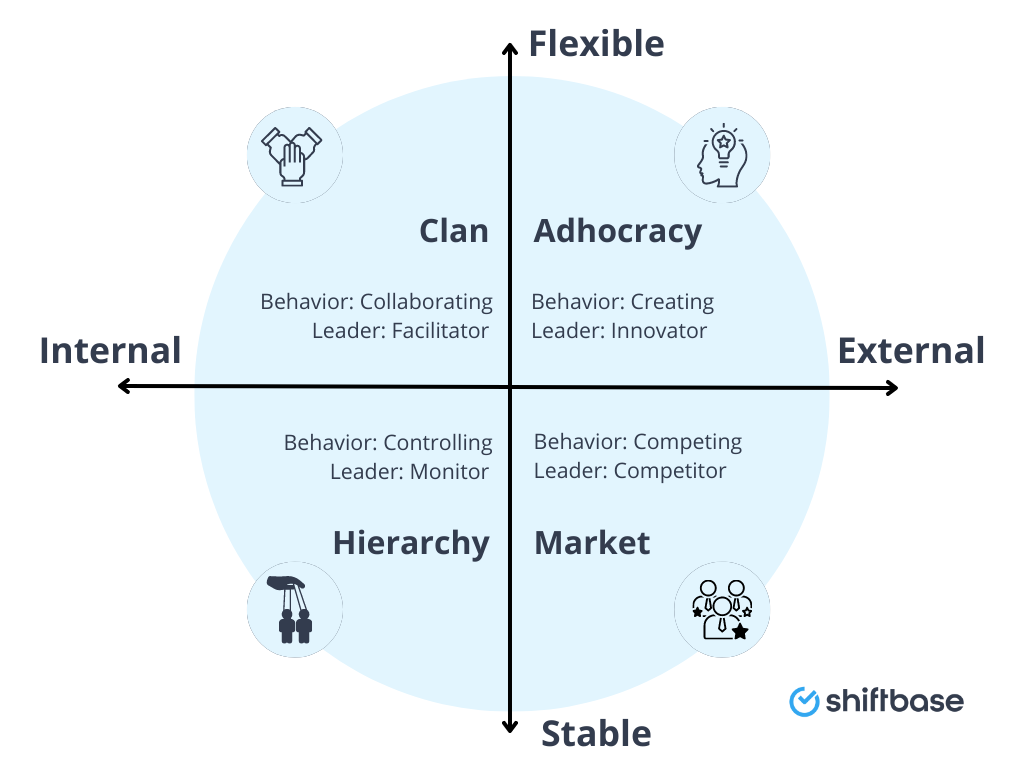What is a corporate culture?
Corporate the term corporate culture and, as a term, encapsulates the collective values, beliefs, attitudes, and practices that define own unique culture of an organization. The underlying framework shapes how employees interact with one another and engage with their superiors, customers, and other stakeholders.
Corporate culture is often ingrained within an organization, subtly influencing employee behaviour and decision-making processes. As a result, it plays a critical role in determining a company's overall performance and success.
Why is corporate culture important?
Corporate culture is more than just free lunches and ping pong tables. It's the lifeblood of an organization, shaping everything from employee engagement to business success. Here's why HR managers and employers should prioritize fostering a strong corporate culture:
-
Boosts Recruitment and Retention: A positive culture attracts top talent and keeps them happy. People are more likely to be drawn to and stay with companies that offer a sense of belonging, purpose, and growth opportunities.
-
Enhances Productivity and Performance: When employees feel valued, supported, and empowered, they're more likely to go the extra mile. A strong culture fosters collaboration, innovation, and a drive to achieve shared goals.
-
Reduces Costs: High turnover is expensive. A positive culture that retains employees translates to significant cost savings.
-
Strengthens Employer Brand: A positive culture goes beyond the company walls. Satisfied employees become brand ambassadors, attracting new talent and clients.
Which elements constitute corporate culture?
A great corporate culture drives a company's success and creates a supportive, productive environment. The following are ten key characteristics that define a thriving corporate culture:
Strong core values
A solid foundation of well-defined values guides an organization's decision-making process and is a compass for employees. Companies with strong values exhibit clear direction, unity, and purpose.
Useful Read: Organizational Values: The Guiding Compass of Successful Businesses
Open management philosophy
Companies that foster open communication and encourage employee involvement in decision-making processes create an environment of trust, respect, and innovation. This approach empowers employees and helps cultivate a sense of ownership and responsibility.
Positive organizational culture
A positive work atmosphere contributes to employee satisfaction, motivation, and productivity. By promoting a supportive and collaborative environment, organizations can boost morale, enhance teamwork, and inspire employees to reach their full potential.
Risk-taking mindset
Encouraging employees to take risks and embrace challenges fosters innovation and growth. Companies that cultivate a risk-taking culture are likelier to stay ahead of the competition and adapt to changing market conditions.
Emotional environment
Recognizing and addressing employees' emotional needs is essential for creating a healthy environment. Companies prioritizing emotional well-being demonstrate empathy and care for their employees, leading to greater loyalty and commitment.
Outcome orientation
A strong focus on results drives organizations to set high-performance standards, strive for continuous improvement, and measure success through tangible outcomes. This approach encourages employees to align their efforts with the company's objectives.
Employee retention
A great corporate culture attracts and retains top talent, reducing turnover and ensuring continuity within the organization. By investing in employee development and creating a positive environment, companies can enhance their ability to retain valuable team members.
Competitive edge
A strong corporate culture enables organizations to differentiate themselves from competitors, creating a unique brand identity that appeals to customers and employees. This competitive advantage can lead to increased market share and long-term success.
Customer satisfaction
Companies can enhance their reputation and build lasting relationships with clients by instilling a culture prioritizing customer needs and expectations. Satisfied customers are likelier to remain loyal and recommend the company to others.
Adaptable to change
Companies with a strong culture and a flexible and resilient corporate culture are better equipped to navigate market fluctuations, embrace new technologies, and seize emerging opportunities.
Advantages of a positive corporate culture
Investing in a positive corporate culture pays off in numerous ways:
- Improved Employee Engagement: Employees who feel valued and connected are more likely to be passionate, motivated, and productive.
- Enhanced Innovation and Creativity: A culture that encourages open communication and risk-taking fosters a breeding ground for new ideas and solutions.
- Stronger Customer Focus: A positive internal culture translates to a better customer experience as employees are empowered to deliver excellent service.
- Reduced Conflict and Turnover: A healthy culture minimizes negativity and fosters a sense of community, leading to lower turnover rates.
- Increased Profitability: When all these elements come together, companies with strong cultures tend to outperform their competitors in the long run.
By understanding the importance of corporate culture and its key elements, HR managers and employers can create a work environment that attracts, retains, and motivates top talent, ultimately driving business success.
Types of corporate culture

Corporate cultures vary significantly across different companies, and understanding these variations is crucial for effectively managing and shaping a company's unique culture. Cameron and Quinn's Competing Values Framework (CVF) identifies four distinct types of organizational culture: clan, adhocracy, market, and hierarchy.
Clan culture
The organization's strong emphasis on collaboration, teamwork, and a sense of family characterizes clan culture. This culture fosters a supportive and nurturing environment where employees feel valued and included. Communication in a clan culture is typically open and informal, focusing on maintaining positive relationships and resolving conflicts through consensus.
Clan cultures often prioritize employee development and satisfaction, leading to high levels of loyalty and commitment. However, the emphasis on maintaining harmony and avoiding conflict between multiple cultures may sometimes hinder decision-making and slow the implementation of necessary changes.
Adhocracy culture
An adhocracy culture is a business environment focusing on innovation, creativity, and adaptability. This type of culture encourages employees to take risks, experiment with new ideas, and embrace change as an opportunity for growth. Organizations with an adhocracy culture are often characterized by a flat structure, allowing for flexibility and rapid decision-making.
While this culture type can drive significant innovation and progress, it may also lead to a lack of stability and consistency, with employees potentially feeling overwhelmed by the constant change and lack of clear direction.
Market culture
Market culture strongly emphasizes results, competition, and achieving organizational goals. Companies with a market culture often prioritize customer satisfaction and financial performance, setting ambitious targets and closely monitoring progress.
Employees in a market culture are typically driven, goal-oriented, and focused on achieving measurable outcomes. While this culture type can lead to impressive financial results and market dominance, it may also create a high-pressure environment where employees feel stressed and burned out, potentially leading to high turnover rates and reduced job satisfaction.
Hierarchy culture
A focus on structure, control, and adherence to established procedures, traditional hierarchies, and policies characterizes hierarchy culture. This type of cultural value;
- Stability
- Predictability
- Efficiency
- With clearly defined employee roles and responsibilities.
Communication in a hierarchy culture typically follows a top-down approach, with decision-making authority centralized at the top levels of management. While this culture type can ensure consistency and minimize risk, it may also stifle innovation and creativity, making it difficult for the organization to adapt to new challenges and market conditions.
Examples of corporate culture in action
Here are some examples of companies known for their distinct corporate cultures:
Innovation-Driven:
-
Google: Empowers employees with autonomy and resources to pursue innovative projects, fostering a culture of "thinking outside the box."
-
3M: Champions a culture of experimentation with their famous "15% time" policy, allowing employees to dedicate a portion of their workday to personal creative pursuits.
Collaboration-Focused:
-
Valve: Employs a flat organizational structure, encouraging open communication and teamwork across disciplines.
-
Zappos: Values a strong company culture built on core values like "delivering WOW" through exceptional customer service, fostering a collaborative and service-oriented environment.
Results-Oriented:
-
Amazon: Renowned for its focus on speed, efficiency, and customer obsession. This high-performance culture can be demanding but fosters a drive for continuous improvement.
-
Salesforce: Known for its "Ohana" culture, emphasizing a strong sense of family and community, while maintaining a competitive and results-oriented environment.
Employee-Centric:
Remember: These are just a few examples, and there's no one-size-fits-all approach to corporate culture. The key is to develop a culture that aligns with your company's values, goals, and target talent pool.
Creating a corporate culture

Building a strong corporate culture takes time, effort, and commitment from leadership and employees alike. Here's a roadmap to get you started:
1. Define your ideal culture:
- Brainstorm: Gather leadership and consider what kind of environment you want to create. What are your core values? What behaviors do you want to encourage?
Useful Read: From Positive to Problematic: 12 Workplace Behavior Traits
- Employee Input: Conduct surveys or focus groups to understand what employees value in a work environment. This inclusivity fosters buy-in from the start.
2. Align with mission and vision:
- Ensure your company's mission, vision, and values are clearly defined and understood by everyone.
- These guiding principles should be the foundation of your culture.
3. Leadership by example:
- Leaders set the tone. Ensure leadership actions and decisions embody the company's values.
- Employees look to leaders for guidance, so authenticity is key.
4. Onboarding and recognition:
5. Communication and transparency:
- Keep employees informed about company goals, decisions, and challenges.
- Open communication builds trust and fosters a sense of shared purpose.
6. Work environment and flexibility:
- Consider the physical workspace. Does it reflect the desired culture? Is it collaborative and well-equipped?
- Explore flexible work arrangements to promote work-life balance and employee well-being.
7. Continuous improvement:
- Building a strong culture is an ongoing process.
- Regularly gather employee feedback through surveys or focus groups to identify areas for improvement.
Additional tips:
- Celebrate wins and milestones together, big or small.
- Organize social events and team-building activities to foster connections.
- Encourage professional development opportunities for employees.
- Be open to new ideas and feedback; a strong culture is constantly evolving.
By following these steps and fostering a culture of open communication, collaboration, and recognition, you can create a work environment that attracts and retains top talent, ultimately driving your business success.
.png?width=323&height=124&name=img-16%20(1).png)
Employee scheduling and Time-tracking software!



.png?width=323&height=124&name=img-16%20(1).png)





